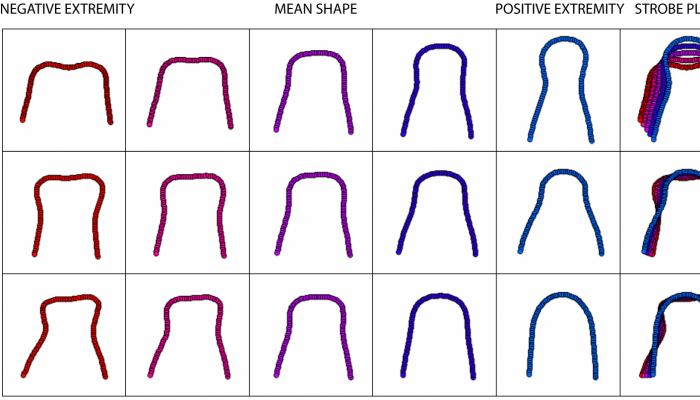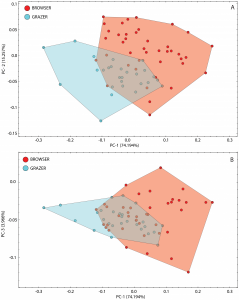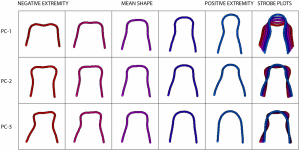
So the last couple of posts have been a bit of an eclectic mix of open access-y stuff and some of the research I’ve been doing on crocodiles as part of my PhD. This one is gonna be a bit of a change, about research that I recently published following my masters project a couple of years back. Weirdly, this was on the snouts of ruminants, and what they can tell us about their ecology.
The whole idea behind the project was to test previous research – to what degree can we use the different snout shapes exhibited by ruminant species to infer their ecology, based on feeding style. Traditionally, ruminants are classified into two groups – browsers and grazers – with the former being ascribed ‘pointed’ snout shapes, and the latter a more ‘blunt’ shape, for a more random cropping process when eating. We wanted to see what degree this was accurate.
This is actually fairly important, for something that might seem pretty simple on the face of it. Snout shape has been found to be strongly correlated with selectivity of forage, as well as intake rate of food, which is significant as this impacts upon almost all other physiological factors involved in ingestion and digestion. So testing the relationship between snout shape and ecology as important as it impacts upon many other areas of ruminant ecology.
So while this association has been demonstrated before and used broadly within the pretty massive field of ruminant ecology, and we set out to see if we could replicate the relationship using different data and methods. Nothing too ground breaking, but a nice little project.
We looked at 121 different ruminant species, a vastly broader dataset than previously used, combined with an approach known as geometric morphometrics. This method uses geometric coordinate data to analyse the differences in shape or form of an object – in this case, the outlines of ruminant snouts. Using these data, it is then possible to run further analyses such as principal coordinates analysis to visualise the data in different ways.
We employed a fairly sophisticated suite of analyses that allowed us to see if different groups could be distinguished based on the shapes of their snout profiles, assigning animals to different ecological groupings based on secondary criteria taken from the literature. What we found, is that in about 80% of cases, ruminants could be successfully assigned to their designated ecology based on snout shape alone – great! This was based on a discriminant analysis, which uses groups as a variable to try and maximise the distance between groups. Then you can see which individual species plot within their group proximities, or if they actually seem to be more closely related to other groups.

Principal component plots for snout shapes, with ruminants classed according to their feeding ecology. Tennant and MacLeod (2014)
We were also able to use this information to figure out what the ecologies of ruminants who had an uncertain grouping were, with a fairly high degree of certainty. This could be of use for palaeoecologists, as it provides a fairly simple way of inferring the ecology of extinct ruminant species.
Additionally, it seems that the while the evolutionary relationships of the analyses species is important in determining the similarity of snout shapes within the sample we analysed, when you account for this by ‘correcting’ for phylogenetic similarity, the overall dispersal structure of the specimens in the analyses remained the same. This implies that while closely related species retain similar snout shapes with each other, as we might expect, there is still an external driving factor acting to constrain snout shape varieties.

What the snout shapes along the three major shape axes look like. Bit more complex than a blunt-pointed transition, don’t you think? Tennant and MacLeod (2014)
Which is nice, as then when we compared body mass to snout shape, we found a strong relationship between between the two for both the browsing and grazing groups. This provides strong evidence that it is some aspect of ecology related to body mass, such as forage intake rate, that is acting in concert to drive evolution of snout shape, as one might expect if it is functionally significant in feeding.
That’s pretty much it for this one. We did run some preliminary comparative analyses with this data set and that for ornithopod dinosaurs, but decided not to pursue this avenue for publication. The data is all available in its raw form along with the paper, and to run the analyses I did requires only a few lines of code which I’d be happy to provide (guilty for not publishing it along with the paper..) For now though, this is a nice feather in my cap I think. It’s a pretty methods heavy paper, and unrelated to my current research, but thanks to my supervisor and some excellent reviews and editorial control, I really learned quite a lot of awesome techniques that I’m applying to my current research.
I hope you enjoy the paper! Now, where are those crocs..
Tennant, J. P. and MacLeod, N. (2014) Snout shape in extant ruminants, PLOS ONE, 9(11), e112035. (OA link)

Pingback: Morsels For The Mind – 09/01/2015 › Six Incredible Things Before Breakfast